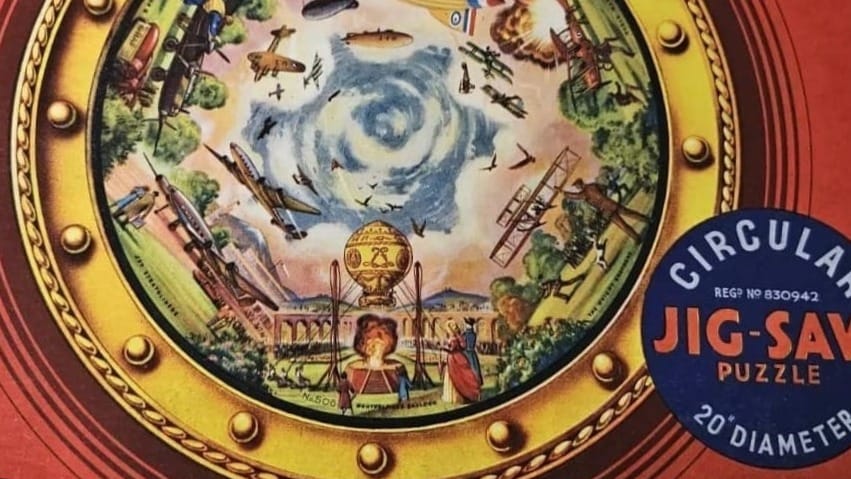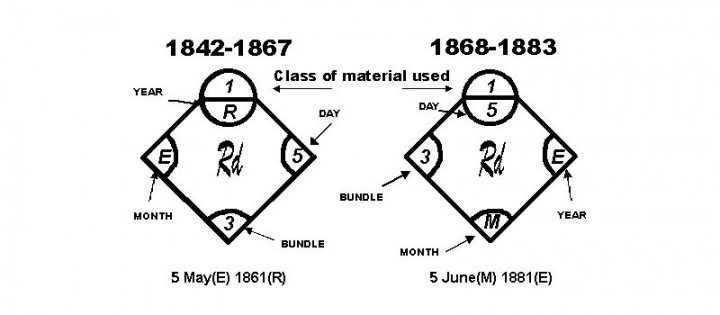Dating English Jigsaws

Starting points
Here are some of my favourite sneaky ways to date jigsaws.
- visiting a specialist website such as Jigasaurus
- pinning down the jigsaw company's history e.g. establishment, brand names, logos, mergers and take-overs, closure - you can use the UK government's company search as a starting place
- looking for adverts in newspaper and magazine archives
- consulting vintage catalogues
- identifying specific items, vehicles, fashions, or hairstyles, in the image
- referring to a jigsaw reference book
Marks, stamps, and prices
When trying to date vintage jigsaws it's sometimes possible to narrow down the dates using clues written on the box or on the edge of the puzzle. The following clues relate to marks, stamps, and prices found on jigsaws or their boxes. They are arranged here in date order.
Diamond Marks 1842-1883
These registration marks were issued when a design was registered by the Patent Office, but only for designs registered under the terms of the 1842 Ornamental Designs Act. They were most commonly used in the textile industry and in the potteries, and I don't think they were ever used for jigsaws, but there is a wood class into which wooden toys might fit. The Utility Designs Act 1843 extended protection to functional features such as shape and configuration. The National Archives provides this diagram to explain how diamond marks are interpreted:

Limited Companies 1860-
In 1860 the Companies Act created the status of Limited Companies, so this may be seen on company names after this date.
Trade Mark 1862-
The use of Trade Marks was established by the Trade Marks Act of 1862.
[Company Name] Ltd. 1880-
From about 1880, companies started to use the abbreviation Ltd.
Registered Design Numbers 1884-1950
The Patents, Designs and Trade Marks Act set up a basic numbering system to replace the complicated diamond mark system. The number indicates the first year of manufacture, but usually this does not apply to the jigsaw image, but to the cut. A design could be used over a number of years, so the number on any individual jigsaw does not necessarily show the year that particular example was made. For example, Waddington's registered their circular jigsaw cutting design with the number 830942 in 1938, but the 'History of Flight' puzzle from the 'Porthole' series labelled with this number was made in 1953-54. (See image at top of page).
The following list shows the first number issued each year from 1884 onwards.
1884 starts with number 1
1885 starts with number 18,993
1886 starts with number 39,547
1887 starts with number 61,207
1888 starts with number 87,266
1889 starts with number 111,664
1890 starts with number 140,481
1891 starts with number 160,613
1892 starts with number 183,259
1893 starts with number 203,348
1894 starts with number 223,861
1895 starts with number 244,726
1896 starts with number 266,237
1897 starts with number 288,848
1898 starts with number 309,956
1899 starts with number 328,527
1900 starts with number 349,120
1901 starts with number 367,628
1902 starts with number 380,979
1903 starts with number 401,944
1904 starts with number 422,489
1905 starts with number 422,489
1906 starts with number 428,004
1907 starts with number 469,160
1908 starts with number 486,464
1909 starts with number 516,375
1910 starts with number 533,561
1911 starts with number 546,084
1912 starts with number 561,570
1913 starts with number 585,707
1914 starts with number 608,541
1915 starts with number 627,887
1916 starts with number 642,613
1917 starts with number 651,079
1918 starts with number 662,576
1919 starts with number 665,728
1920 starts with number 664,869
1921 starts with number 676,491
1922 starts with number 685,412
1923 starts with number 691,571
1924 starts with number 695,944
1925 starts with number 705,943
1926 starts with number 716,386
1927 starts with number 723,430
1928 starts with number 725,899
1929 starts with number 740,459
1930 starts with number 741,336
1931 starts with number 757,945
1932 starts with number 767,110
1933 starts with number 777,000
1934 starts with number 788,000
1935 starts with number 793,000
1936 starts with number 808,000
1937 starts with number 817,000
1938 starts with number 825,000
1939 starts with number 833,000
1940 starts with number 836,000
1941 starts with number 837,000
1942 starts with number 838,000
1943 starts with number 839,000
1944 starts with number 841,000
1945 starts with number 843,000
1946 starts with number 846,000
1947 starts with number 848,000
1948 starts with number 853,000
1949 starts with number 857,000
1950 starts with number 860,000
Exported Goods 1891-1909
In 1891, the McKinley Tariff Act instigated a requirement that all products imported into the USA had to show their country of origin. During this initial period any jigsaws exported to the USA had to carry the word ‘England’. Remember, however, that some manufacturers may have included the word England before this, perhaps for non-export-related reasons!
The Copyright Symbol 1909-1988
The copyright symbol, a 'c' in a circle like this ©, was introduced in the US as part of the Copyright Act in 1909. There is no specific date when this was adopted officially in the UK, but it gradually came into use over time. If you see one on a box it is usually accompanied by the date. This date usually applies to the image rather than the cut and it may, or may not, reflect the manufacturing date of the puzzle. under the Berne Convention, the symbol is no longer required in most countries, but it is still widely used, so there is no end-stop date.
Exported Goods 1909-
After 1909 manufacturers started to use ‘Made in England’ and later, with some overlap, they began to use ‘Made in Britain’. Remember, again, that some manufacturers may have included the word England before this, perhaps for non-export-related reasons!
Sales Taxes 1940-
The first sales taxes were applied in Britain on 19th October 1940. Price labels produced before this date will never mention purchase tax - but don't forget that the absence of tax information doesn't necessarily mean that something was made before 1940. However, you can be certain that on British jigsaws, price labels which include purchase tax will only be on puzzles sold after 1940.
Decimalisation
In the UK and in Ireland, decimalisation took place on 15th February 1971. Before this date price labels will show pounds, shillings and up to 11 pence. After this date price labels will show pounds and up to 99 pence.
Want more of my jigsaw content?
Please visit my jigsaw channel on YouTube - JigsawsGently!
